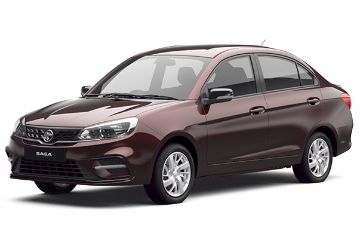![New Proton Saga – Could This Be A Better Car Than The Perodua Bezza? 01]()
The Proton Saga is Proton’s bread and butter model, a model that has been (and still is) the default first car option for many car buyers.
That quickly changed when Perodua introduced its first-ever sedan, the Bezza, back in 2016. Car buyers now have a new alternative to the evergreen Saga.
![New Proton Saga – Could This Be A Better Car Than The Perodua Bezza? 02]()
The third generation Saga was introduced just two months after Perodua unveiled the Bezza, giving its core model a much-needed upgrade.
Earlier this week, Proton launched the new Saga, which is basically a mid-life update for its third-generation model.
![New Proton Saga – Could This Be A Better Car Than The Perodua Bezza? 01]()
Three variants are available as Proton has consolidated the model line-up.
Specifications for Proton Saga 1.3:
- Engine: 1.3-litre VVT four-cylinder, naturally-aspirated
- Transmission: 5-speed manual or 4-speed automatic, front-wheel drive
- Power: 95 PS at 5,750 rpm
- Torque: 120 Nm at 4,000 rpm
- Price: From RM 32,800 to RM 39,800
- Origin: Manufactured in Shah Alam, Selangor
Here’s a brief summary comparing the three different variants of the new Proton Saga.
![New Proton Saga – Could This Be A Better Car Than The Perodua Bezza? 02]()
Which variant to buy?
Our pick of the range for the new Proton Saga is the Saga Premium AT, as it includes stability control and traction control for not a lot of money.
How good is that floating touchscreen head unit?
![New Proton Saga – Could This Be A Better Car Than The Perodua Bezza? 03]()
For starters, the touchscreen head unit does not support the “Hi Proton” voice command system.
However, it does have EasyConnection, which is a method for users to mirror their phones to the head unit. Users are required to download the EasyConnection app from the Google Play Store in order to use this feature.
![New Proton Saga – Could This Be A Better Car Than The Perodua Bezza? 04]()
Similar to MirrorLink, those using EasyConnection must have their phones’ display constantly turned out, in turn draining battery as most USB ports cannot charge the device quick enough to compensate for the battery draining.
With such a nice display in place, it would have been nice if Proton included Apple CarPlay and Android Auto support.
Does the new Saga drive well?
We’ve yet to sample the new Saga, but considering that Proton has removed the Punch-sourced CVT-type automatic, replacing it with a Hyundai-sourced 4-speed torque converter automatic, we’re expecting the new Saga to offer better refinement levels as the previous CVT was the Achilles heel of an otherwise decent little sedan.
![New Proton Saga – Could This Be A Better Car Than The Perodua Bezza? 05]()
New transmission aside, ride and handling has always been Proton’s hallmark and the Saga is no different.
Similar to the more expensive Iriz and Persona duo, the Saga takes road irregularities with ease, soaking up bumps without affecting passengers too much.
![New Proton Saga – Could This Be A Better Car Than The Perodua Bezza? 06]()
Even when driven hard, the Saga remains as a capable machine as grip levels are pretty decent, while the hydraulic power steering provided ample feedback.
Should I buy the new Saga or the Bezza?
When it comes to choosing between the new Saga or the Perodua Bezza, either car would be a great option.
![New Proton Saga – Could This Be A Better Car Than The Perodua Bezza? 07]()
For those who values ride comfort, the new Saga offers a superior ride comfort over the Bezza. Similar to the Myvi, the Bezza’s ride is considerably harsher, while handling is nothing to write home about.
The new Saga is also the cheapest new sedan on the market right now (RM 39,800) to offer stability control and traction control. The only Bezza variant to offer stability control and traction control is the Bezza 1.3 Advance, which is an extra RM 8,000 over the Saga.
![New Proton Saga – Could This Be A Better Car Than The Perodua Bezza? 08]()
In fact, for taller drivers, we reckon that the Saga is a better option as it comes with steering wheel height adjustment, making it easier to adjust the steering wheel for a more relaxed driving position. The steering wheel on the Bezza is fixed.
![New Proton Saga – Could This Be A Better Car Than The Perodua Bezza? 09]()
However, the Bezza claws back with its superior fuel economy, courtesy of its Dual VVT-i engine and lighter curb weight. Perodua says that the Bezza can return up to 22 km/l with its Eco Idle (Engine start/stop), while Proton has yet to release fuel consumption figures of the new Saga. This comes at a cost, as battery replacement for Bezza models with Eco Idle is more expensive than the Saga (about RM 300 for AGM-type batteries)
![New Proton Saga – Could This Be A Better Car Than The Perodua Bezza? 10]()
In terms of practicality, the Bezza offers a thoughtful ‘handbag hook’ located on the side of the front passenger seat. At 508 litres, the Bezza’s boot space is also considerably more than the Saga’s 420 litres.
![New Proton Saga – Could This Be A Better Car Than The Perodua Bezza? 11]()
Similar to other Perodua models (except the Aruz), the Bezza’s air-conditioning system is a multi-blower type, capable of directing cool air to the front passenger’s foot well or the windshield. The Saga’s air-conditioning system is a single mode blower that blows cool air to the front passengers.
Last but certainly not the least, the Perodua Bezza has better residual value and comparatively better after-sales support.



















